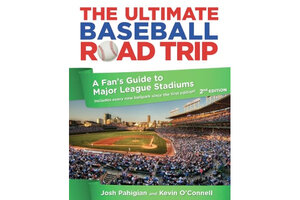The Ultimate Baseball Road Trip, 2nd Edition
This guide to all 30 major-league baseball stadiums manages to be thorough, enthusiastic, and quite entertaining.

The Ultimate Baseball Road Trip, 2nd Edition
By Josh Pahigian and Kevin O'Connell
Globe Pequot Press
512 pp.
Josh Pahigian and Kevin O’Connell have done what many baseball fans only dream about doing, and they’ve done it not just once, but twice. Their fantasy come true? Attending games at all 30 major-league stadiums, and doing it during one whirlwind season.
Their travels form the basis of “The Ultimate Baseball Road Trip, 2nd Edition,” a nearly 500-page guide that mixes detailed descriptions of each big-league ballpark, team histories, and reviews of food and baseball-related city attractions.
The original opus was published in 2004, when the authors were fresh out of grad school. Even though they both now have families, complicating a reunion tour, their publisher supported revisiting the subject matter in a 2.0 version, partly because eight new ballparks have been built in the interim. And partly because the fan response to the first book, in letters and e-mails, was so encouraging.
Why are fans so enamored of baseball parks? Probably because a sense of place is so integral to the experience of attending a game. Stadiums have their own individual character, created by differing field dimensions and outfield walls, which are such a focal point and factor in the outcome of many games. Plus, these days, as the authors underscore, teams strive mightily to enhance the ambience inside and outside parks with everything from kid zones and team museums to fair-like concession areas and water features.
As many as 20 pages are devoted to each ballpark, yet there are no seating diagrams explaining the pros and cons of various sections. The reason is simple. Links are provided to the team websites that carry ticket information and seating charts. In this vein, links are also shared to baseball blogs, Web forums, and the menus of restaurants and bars in ballpark neighborhoods.
The authors clearly love eating and sampling both stadium and nearby restaurant fare. Just how they manage to critique so many options (a dozen or more in each city) is a mystery, but maybe some of the input comes from other fans.
Assessing ballpark hot dogs, of course, is the starting point. L.A.’s famous Dodger Dogs are decreed a bland disappointment. And the Tiger Dogs at Detroit’s Comerica Park are a letdown, too, except that buying one from the operatic vendor in Section 100 makes up for taste shortcomings. The authors find winners along the way, in D.C. and New York, for example, but they consider frankness (pardon the pun) as an important part of their job description.
Mostly, however, they find much to be enthusiastic about in attending games these days. The art and science of ballpark building, it seems, have nearly been perfected, with stadiums sporting superior sight lines, spacious concourses, huge videoboards, and all sorts of entertainment extras and artistic flourishes.
As for where to stay near these ballparks, well, “Road Trip” doesn’t touch that subject, a surprising omission for a travel guide. But maybe that’s because the authors slept on friends’ couches wherever they could, even while traveling on the publisher’s dime and receiving complimentary seats from many teams. Still, given the challenges of finding affordable, convenient accommodations in many cities, some housing tips would be welcome.
That said, the appendix shares fan-friendly itineraries for four sample trips, one of East Coast ballparks dubbed “Babe Ruth Big Eating Tour” and the others for regional swings through the South, Midwest, and West.
How the authors did their “work” is interesting and provides one of the funniest sidebars in the book. The episode unfolded during a game at Houston’s Minute Maid Park, where the coauthors had unknowingly secured seats 24 rows behind President H.W. Bush, an Astros fan.
To scout out the ballpark, McConnell left his seat to head for the upper deck to take pictures. Shortly after he took out his camera, however, a security guard approached the author.
Guard: “How do you feel about our former president?”
McConnell: “Excuse me?
Guard: “Oh, you heard me. “
Asked to explain what he was doing taking pictures and occasionally speaking into a microcassette recorder, McConnell described his book project and how the recorder helped him file audio notes for his photo log.
Only after he was released from the interrogation and got back to his seat did things become clear. That’s when stadium P.A. announcer directed the crowd’s attention to the VIP in the box seats.
Ross Atkin is a Monitor staff writer.

